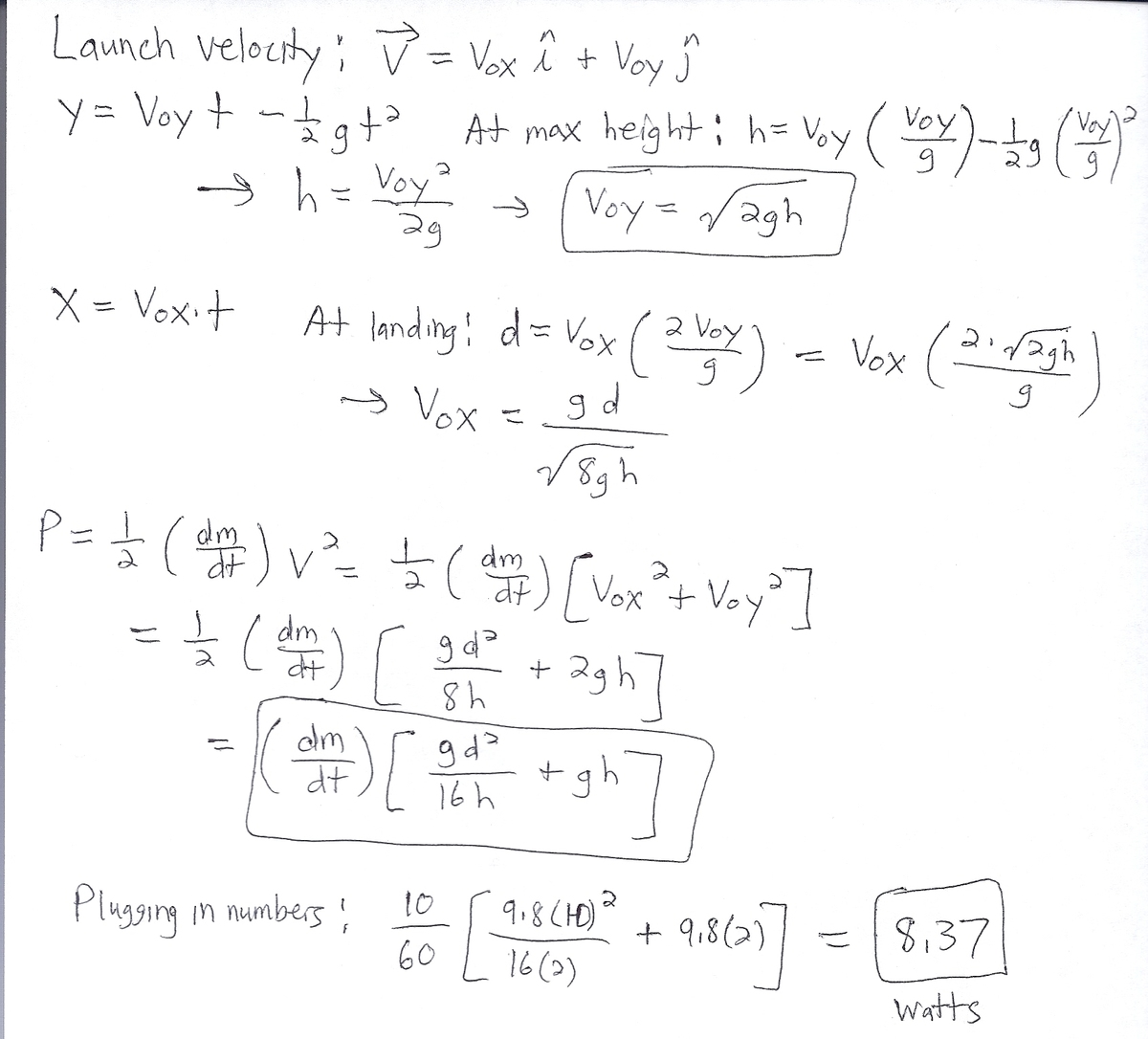Sprinkler Power
A lawn sprinkler sprays water in a parabolic arc. The maximum height of the arc above ground is ( h = 2 m ) , and the stream lands on the ground a distance ( d = 1 0 m ) away from the sprinkler.
If the mass flow rate of water through the sprinkler is ( d t d m = 1 0 k g / m i n u t e ) , determine the absolute minimum power (in Watts) required to operate the sprinkler.
Details and Assumptions:
The gravitational acceleration is
(
g
=
9
.
8
s
2
m
)
Neglect losses, air resistance, movement of sprinkler parts, etc.
Give your answer to 2 decimal places
The answer is 8.37.
This section requires Javascript.
You are seeing this because something didn't load right. We suggest you, (a) try
refreshing the page, (b) enabling javascript if it is disabled on your browser and,
finally, (c)
loading the
non-javascript version of this page
. We're sorry about the hassle.
2 solutions

@Steven Chase
you are a premium member of brilliant and i am not.
I want to ask some questions.
Did you learn everyday something new using premium content??
Till how much extent premium content is useful to you??
How much average time you spend daily in learning premium content??
I didn't taken premium membership till now because I am a jee student and I used to study daily average 8-10hours (excluding Brilliant) , after that I didn't get time. I will take in university next year.
By the way , give answer in a very unbiased way.
Hope you will reply me
Log in to reply
The link gives a description of premium vs. free. I actually don't use any of the features of premium. I never take courses, and I spend 100% of my site time on community problems. I'm effectively just donating to the site to keep it running (in addition to all the time I spend producing community content).
https://brilliant.org/give-premium/
Log in to reply
@Steven Chase
yes I have seen this link very well.
But the question is why are you wasting your money if you doesn't use any feature.?
Log in to reply
@Talulah Riley – It's a charitable donation, because I want the site to keep going
Log in to reply
@Steven Chase – @Steven Chase it means if you stop using premium content, then brilliant site will be closed!! By the way do you pay yearly? And how much?
Log in to reply
@Talulah Riley
–
@Steven Chase
By the way you are doing a good job,
No matter how much the donation is . Thanks
I appreciate it.
First, we have to calculate the energy that is being given to the water as it leaves the sprinkler. For any individual part of the stream, we know that it will travel to a maximum height of 2 metres, and will travel a horizontal distance of 1 0 metres. We know that:
E s = 2 1 m v 2 = 2 1 m ( v x 2 + v y 2 )
In order to find the kinetic energy that arises from the velocity in the y -direction, we simply remember that all of this kinetic energy will be converted to potential energy at the maximum height of the arc, thus:
2 1 m v y 2 = m g h ⇒ v y = 2 g h
We also know that:
x = v x t and y = v y t − 2 1 g t 2
The time at which the water has travelled the distance of 1 0 metres will be when y = 0 , thus:
v y t − 2 1 g t 2 = 0 ⇒ v y t = 2 1 g t 2 ⇒ t = 0 , g 2 v y
We are interested in the second solution, as this allows us to find the velocity in the x direction:
x = v x t ⇒ v x g 2 v y = R ⇒ v x = 2 v y R g
E s = 2 1 m ( v x 2 + v y 2 ) = m g h + 2 1 m ( 2 v y R g ) 2 = m g ( h + 8 h R 2 )
And recalling the definition of power, we have:
P s = dt d E = dt d m g ( h + 8 h R 2 ) = g ( h + 1 6 h R 2 ) dt d m = ( 9 . 8 ) ( 2 + 3 2 1 0 0 ) 6 1 ≈ 8 . 3 7 W
Thanks for the solution. Out of curiosity, how did you find this problem, since it's so old?
Hahaha, I think I was searching around for interesting questions with "power" in the title and I came across this!